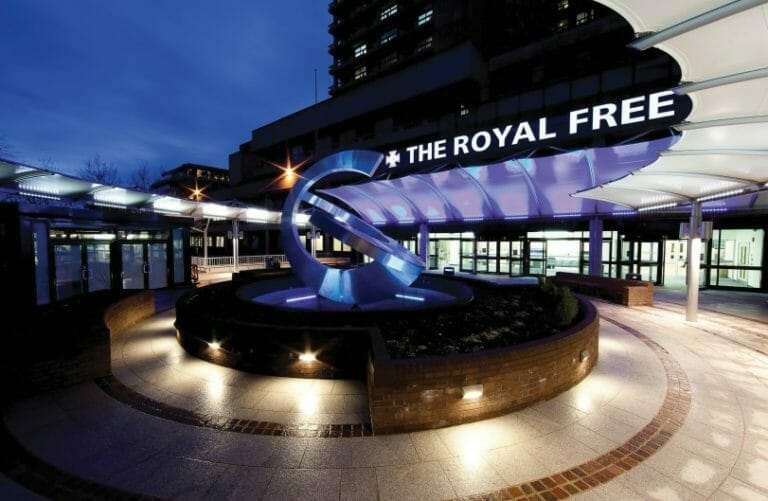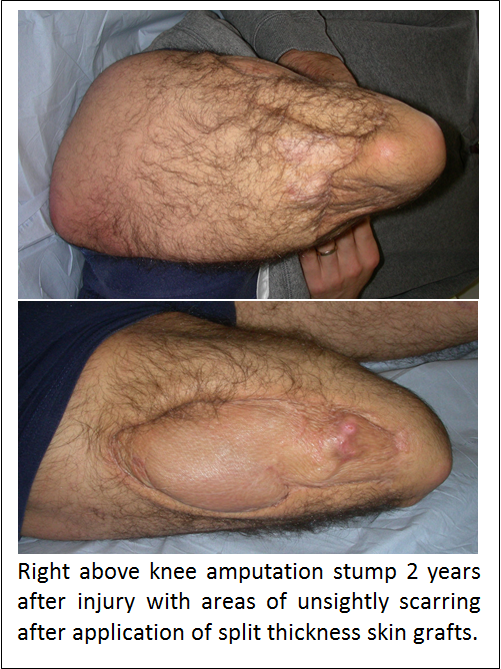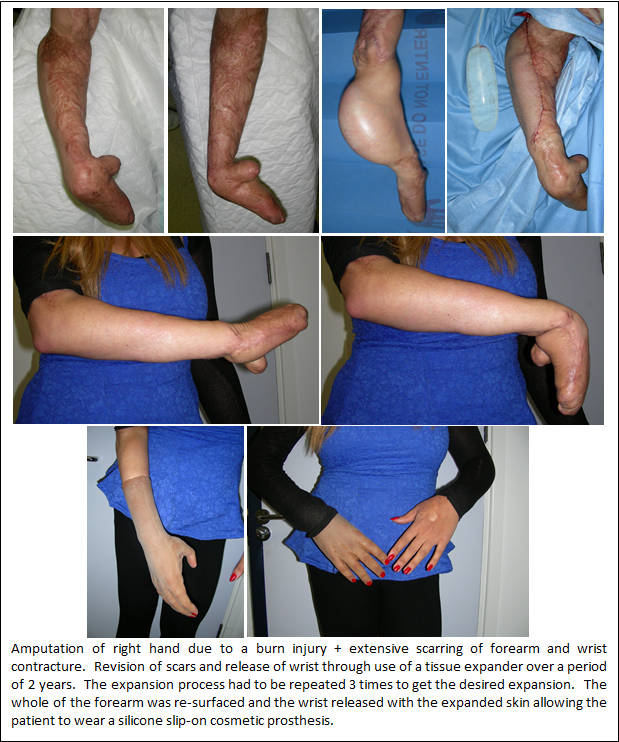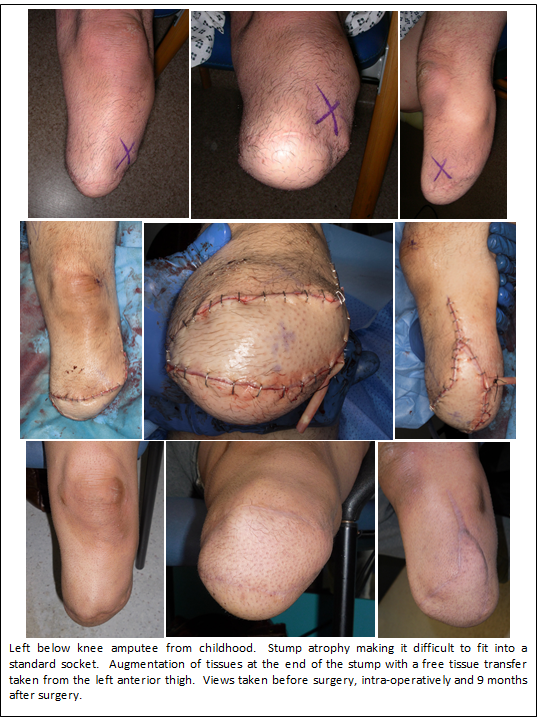Scarring which is unstable, insensate or ulcerated

Our private Scarring which is unstable, insensate or ulcerated services are provided at the Royal Free Hospital, Hampstead.
To find out more about our hospitals click here:
It may be impossible to close the skin after amputation due to the nature of the traumatic event or disease process leading to limb loss. If so, it is sometimes necessary to use skin grafts to achieve skin cover. Unfortunately, a skin graft is essentially a layer of scar tissue with a very thin layer of skin cells on top. Therefore, a skin graft lacks all the normal structures of normal skin including; sensory end organs, oil-secreting glands and a mobile/elastic foundation (dermis).
The absence of sensory end organs means that the graft is insensate meaning that patients may damage an area of skin graft without knowing it since they receive no sensory feedback. The absence of oil-secreting glands makes areas of skin graft prone to dryness, cracking and breakdown. To deal with this, patients must get into the habit of applying oily moisturising creams (e.g. Vaseline) onto the grafts for the rest of their lives. The absence of the dermis means that skin grafts are generally inelastic and immobile.
To deal with these problems, we can sometimes remove areas of skin graft and resurface the residual limb with normal skin using:
- Serial excision
- Tissue expanders
- Imported tissues (as a free flap)

Serial Excision
Serial excision (as the name suggests), removes small areas of skin graft at each operative procedure until all the grafts are removed. Serial excision achieves this outcome by relying on the natural elasticity of the normal skin surrounding an area of skin graft.
At each operative step, this normal skin is pulled forcibly into the area of the previous skin graft and thereby, it gradually stretches into position. Serial excision is particularly effective in dealing with small areas of skin graft. However, for more extensive areas of skin graft, tissue expanders may need to be used. In general, if your surgeon believes that it will take 4 to 5 serial excisions to remove your skin graft, then you may well be better off having a tissue expander inserted.
Tissue Expansion
Tissue expansion uses silicone balloons placed under the normal skin adjacent to an area of skin graft. The balloons are enlarged by regular injections of saline or water resulting in stretching of the overlying skin. Given time, it is possible to stretch the skin enough to allow areas of skin graft to be removed and replaced with normal looking and sensate skin. The main disadvantages of tissue expansion are:
- Length of time taken to expand the skin. For large areas, it may take 3 to 6 months (or more) to achieve the desired degree of expansion.
- Risk of infection of the expander
- Risk of extrusion of the expander through the skin
- Injury to adjacent structures due to stretching or compression as the expander enlarges
- While the expanders are in place, the residual limb looks unsightly and the patient will be unable to use a prosthesis.

Tissue transfer (free flap) surgery
When there is not enough tissue nearby to resurface an injured area, it is sometimes possible to import tissues from elsewhere on the body in the form of a free flap. A free flap takes a composite block of tissue from elsewhere on the body (e.g. from the abdomen or back) and transfers it to the residual limb reconnecting the blood supply using microsurgical techniques.
It is sometimes possible to kill several birds with one stone using a free flap. For example, the tissue that is transferred can include a nerve supply that allows us to restore sensation to part of the residual limb, while simultaneously allowing us to remove areas of unstable scar (skin grafts).

Pre And Post-op Management
Anaesthetic: Patients undergoing scar revision surgery of this kind will usually require a regional block (e.g. axillary or spinal anaesthetic) or a general anaesthetic. You can discuss your specific requirements with our anaesthetists before surgery.
Length of stay: This depends on the specific nature of the procedure performed in your case. Serial excision and tissue expansion can be performed as a daycase procedure. However, undergoing a free flap procedure will require a minimum 2 to 3 night stay after surgery – assuming there are no post-operative complications.
Pain control: Pain levels after surgery vary from one individual to the next. In general, pain levels after serial excision and tissue expansion surgery are usually relatively low and can be managed with simple opiates (e.g. codeine or tramadol) taken orally for a few days. Free flap surgery is much more invasive and so your analgesic requirements are likely to be higher and to last for longer. Discuss your specific requirements with your anaesthetist before discharge.
Wound care: Wound care after serial excision and tissue expansion surgery is usually simple. Wound care after free flap surgery is more complicated because you will have two wounds to consider – one on your residual limb, the other at the donor site for your flap. In all cases, you can shower immediately but should not soak your wounds in a bath for 2 -3 weeks. Running water is fine. If you do shower, your dressings will get wet and will probably come off. Do not worry. We will supply you with adhesive dressings to replace them. Pat your wound(s) dry with clean tissue paper and leave your wound(s) exposed to the air for 15-30 minutes. Then apply a new adhesive dressing.
Tissue expansion: Once your wounds have healed and stabilised (typically 2-3 weeks after surgery but sometimes longer) you will be ready to begin the expansion process. To do this, you will need to return to clinic on a regular basis to begin with – typically twice a week. At each visit, we will inject fluid (either saline or water) into the expander through an expander port located under the skin. If possible, we like to educate our patients to do the injections themselves or to get a family member or friend to do this for you. That way, you do not need to come to clinic so frequently and can carry on the expansion process yourself in the comfort of your own home. We will supply you with the necessary equipment to do this if you wish. Expansion is complete when your surgeon has decided that there is sufficient extra skin to achieve the reconstruction.
Rehabilitation: Although you do not need any specific rehabilitation exercises after this type of soft-tissue surgery, the shape of your residual limb will of course change, both temporarily and in the long-term. It is likely that you will be unable to use your standard socket immediately after surgery both to avoid problems with your new wound and because your residual limb will be swollen. Once your wounds have healed and any swelling has settled, you will need to have a new socket fitted to your residual limb.
Get in touch
